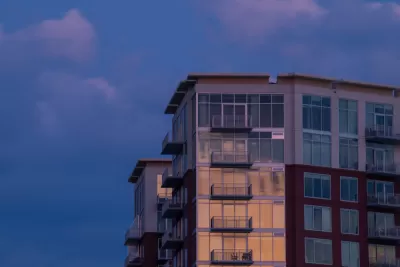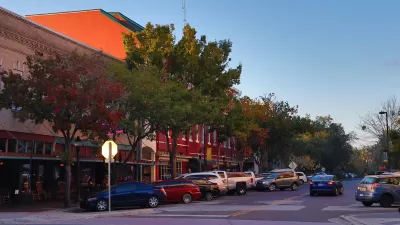Cities are attempting to wrest back local control over land use and zoning via some ingenious—and sometimes disingenuous—strategies.

As state legislatures around the country pass zoning reform laws in an effort to create more housing and stem the affordability crisis facing many Americans, some cities reluctant to build more housing are finding creative (or, from another perspective, misleading) ways to skirt housing requirements and challenge rezoning efforts. Here's a brief survey of some of the cities fighting back against state zoning and housing reforms:
Eco-NIMBYs
In a highly publicized move last month, the Northern California town of Woodside proposed sidestepping state affordable housing mandates by designating the entire locality protected habitat for mountain lions. The town walked back the proposal after receiving swift backlash from housing advocates and others who saw the idea as a cynical ploy, but the proposal could inspire similar actions in other communities.
This wasn't the first time environmental protection has been used to limit new housing construction—far from it. The environmental review process mandated by many states—which calls for assessment of a variety of factors such as air quality, traffic, parking, infrastructure, and more—are often cited in lawsuits by groups that want to stop new development. In many cases, if a project triggers a full Environmental Impact Review (EIR), the analysis can cost hundreds of thousands and take months or years for the developer.
The California Environmental Quality Act (CEQA) has played a key role in lawsuits that delayed or halted projects, and Washington's State Environmental Policy Act (SEPA), adopted in 1972, has also been wielded as a tool for stifling housing production and undermining housing affordability. Appeals filed under CEQA or SEPA can delay projects and raise costs, which some housing advocates say leads to fewer new housing units by giving anti-growth groups an avenue to delay projects and increase costs. Last month, a lawsuit claiming the University of California, Berkeley didn't conduct the appropriate Environmental Impact Report for a proposed increase in student enrollment could force the university to reject thousands of qualified applicants.
Critics of statewide regulations argue that the process often prioritizes car-centric impacts (such as parking and throughput) over sustainable construction methods or materials, for example, assessing potentially valuable housing projects as environmentally harmful. According to a Los Angeles Times article describing the results of a 2018 study, "The real problem isn’t CEQA, but rather how local governments approve projects." As Liam Dillon explains in the article, "CEQA only comes into play if a city or county decides to review housing developments individually." Unfortunately, the discretionary approval process is sometimes coopted by opposition groups who would oppose increased density at any cost.
Preserving History—And the Status Quo
Historic preservation has served as another common method for maintaining low density and undermining housing requirements. In the name of preserving historic architecture, neighborhoods, or important cultural sites, housing supply in many neighborhoods is now far too inadequate for the rising demand. Cities use historic preservation ordinances to impose height limits, parking requirements, and other restrictions on new construction and redevelopment. In some cases, "historic districts" preserve zoning designations that have only been in place for a few decades, and dilapidating, unremarkable buildings receive protections that prevent redevelopment on the site, regardless of what the surrounding neighborhood needs. In Atlanta, the Buckhead neighborhood is considering seceding from the city due to local opposition to the city's new zoning regulations that loosen single-family zoning rules for certain areas near public transit, with some residents arguing that upzoning would degrade the neighborhood's historic character. Many housing advocates call such concerns overblown, pointing to studies that show that only a small percentage of residential properties are affected by upzoning or could reasonably sustain added density.
It's also worth noting that historic preservation can complicate the process of renovating buildings for safety and efficiency. In Seattle, historic designations have made it difficult and expensive to retrofit many of the city's older buildings for seismic safety, while Portland buildings protected by the National Register of Historic Places had to undergo, until recently, an onerous and expensive application process to add energy efficiency features like solar panels or upgraded windows.
Critics say historic preservation designations often become a replacement for the restrictive covenants that, in the past, excluded people of color from many neighborhoods. As this argument goes, freezing development in certain areas effectively raises the cost of housing and ensures that lower-income people can't afford to live there. Designating buildings as historic can also raise their value, making historic neighborhoods even more expensive.
As Dan Bertolet wrote in 2018, "Historic preservation, when it interferes with homebuilding, can worsen a city's shortage of homes, driving up rents and pushing out low-income residents. If cities aren't careful, their historic preservation regulations can function as exclusionary zoning." Experts suggest a cautious, balanced approach to historic preservation that weighs the benefits of preservation against the pressing need for affordable housing.
Density as Displacement
Upzoning efforts sometimes also receive criticism from community members who worry about the displacement and gentrification that frequently accompany redevelopment. While proponents of upzoning say that any increase in available housing units, including market rate housing, will ease pressures on the housing market and contribute to lower housing costs, some community activists argue that displacing homes and businesses to build new developments is disruptive to communities and forces out long-term residents as costs in the area rise. Interestingly, a peer-reviewed 2019 study indicated that new development can actually lower rents in surrounding neighborhoods. But displacement fears aren't entirely misplaced. In Cincinnati, research shows that "The Black population in Over-the-Rhine, one of Cincinnati's hippest urban neighborhoods, 'has declined by 43% in the last decade.'" A 2019 study in Chicago found that upzoning near that city's transit stops increased property values but did not significantly boost the housing supply.
A Delicate Balance
The relationship between upzoning, housing affordability, and displacement, is a complicated one, as is the delicate balance between local control and state preemption with policies aimed at guiding sustainable, equitable development. Experts from across the spectrum tend to agree that zoning reform alone won't solve the housing crisis, and more mechanisms are needed to boost the supply of affordable housing while stimulating local economies, protecting legacy residents and businesses from displacement, and addressing local infrastructure that can support growth. The growing revolt against blanket upzoning may reflect simple NIMBYism—but if states want to make headway in easing the housing crisis, they may need to both boost enforcement of zoning reform and consider more flexible housing policies sensitive to local concerns.

Depopulation Patterns Get Weird
A recent ranking of “declining” cities heavily features some of the most expensive cities in the country — including New York City and a half-dozen in the San Francisco Bay Area.

California Exodus: Population Drops Below 39 Million
Never mind the 40 million that demographers predicted the Golden State would reach by 2018. The state's population dipped below 39 million to 38.965 million last July, according to Census data released in March, the lowest since 2015.

Chicago to Turn High-Rise Offices into Housing
Four commercial buildings in the Chicago Loop have been approved for redevelopment into housing in a bid to revitalize the city’s downtown post-pandemic.

LA County Receives Reconnecting Communities Grants
Seven grant awards totaling $162 million will be used for planning, capital projects, and regional partnerships to reduce environmental harm and improve access in disadvantaged communities.

Seine Pollution Could Hinder Olympic Swim Events
Events like the triathlon could be impacted if tests continue to reveal high levels of dangerous bacteria in Paris’ famous river.

How Financing Restricts the Rental Housing Market
The way apartment buildings are financed has a major impact on supply and costs.
Licking County
Barrett Planning Group LLC
City of Cleburne
HUD's Office of Policy Development and Research
Mpact Transit + Community
HUD's Office of Policy Development and Research
City of Universal City TX
ULI Northwest Arkansas
City of Laramie, Wyoming
Write for Planetizen
Urban Design for Planners 1: Software Tools
This six-course series explores essential urban design concepts using open source software and equips planners with the tools they need to participate fully in the urban design process.
Planning for Universal Design
Learn the tools for implementing Universal Design in planning regulations.























